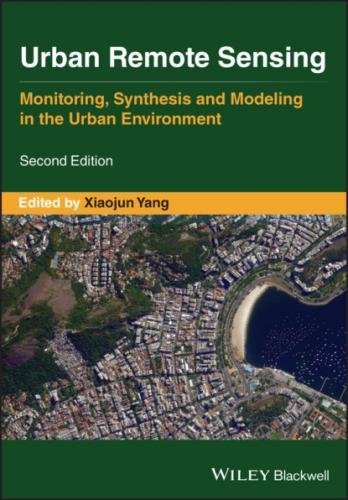3.5 CASE STUDY: MAPPING AN URBAN RECREATION COMPLEX WITH UAS
To better understand the general workflow for UAS data processing, a case study is presented here. This project involved the use of a small UAS to generate 2D and 3D mapping data over a relatively small urban recreation complex through the photogrammetry software package called Agisoft Metashape. For this project, researchers used a small UAS (DJI Phantom 4 Pro) to obtain oblique imagery of an urban recreation complex owned by the City of Auburn, Alabama, USA, and created 2D and 3D mapping data. The workflow used for this project largely followed the same procedure outlined by Nex and Remondino (2014). Since the researchers were interested in generating 3D outputs from the UAS imagery, a flight plan was designed as a double‐grid pattern that would allow the UAS to maintain an oblique camera orientation during the image collection process, which allowed the facades of the buildings and other tall features to be better captured in the imagery. Figure 3.2a depicts the AOI for the mapping mission and Figure 3.2b illustrates the double grid flight plan overlaid on the AoI. This project used the application Pix4D Capture (pix4d.com/product/pix4dcapture) to design and operationalize the UAS image collection flight plan. There are numerous flight planning applications available that have the same core functionality of Pix4D Capture but offer minor differences in user customization and interface design. Some examples of other similar flight planning applications include DroneDeploy [Flight App for Business] (www.dronedeploy.com/product/mobile), Map Pilot by Maps Made Easy (www.mapsmadeeasy.com), DJI Ground Station Pro (www.dji.com/ground‐station‐pro), and Litchi (www.flylitchi.com).
FIGURE 3.2 (a) An aerial view of the Urban Recreation Complex. (b) A flight plan design for UAS data collection. Since the UAS uses oblique camera orientation when capturing images, it needs to flight two grid patterns to capture all four sides of every feature.
To create the desired 3D data outputs (namely, point cloud and a textured model) for this project the user‐defined flight parameters for the flight plan included a flight altitude of 35 m above ground level (AGL), a frontal image overlap of 85%, and side image overlap of 80%, and an oblique camera orientation of 65° (i.e. 90° is nadir orientation). The flight altitude of 35 m allowed the UAS to fly the double‐grid pattern at a low altitude, leading to high‐resolution images to be collected. As previously mentioned, these flight parameters are highly contingent on the specific context that a UAS operator is conducting flights for so their settings can vary from one project to another. For this urban recreation complex mapping project, there were no obstacles of concern above approximately 30 m AGL, so 35 m was a safe flying altitude that would also allow imagery to be acquired at very high resolution. The benefits of this low flight altitude can be seen in the increased quality of resolution in the aerial images, thus leading to a much finer resolution in the geospatial outputs. However, such a low flight altitude does require a much longer flight time than flying at a higher altitude.
After the flights were flown to collect the oblique imagery, the data were then organized and prepared for processing into 2D and 3D photogrammetric outputs. With a photogrammetry software package called Agisoft Metashape, the images were used to generate 3‐D point cloud data that were then georeferenced and can be further used to derive a DSM. Point cloud data consist of points with geographic location and thematic information, derived from commonly matched pixels in the input imagery. Figure 3.3 illustrates the relationship between the input aerial images and the 3D point cloud. With the point cloud data, a DSM can be created which is required to rectify the input images that are used to generate the final combined orthophoto. The process of rectification uses the DSM to remove geometric distortions from the aerial imagery due to relief displacement. In addition to generating DSMs and rectified orthophotos with the point cloud data, users can also generate tiled 3D models that are interpolated point clouds that depict a smooth surface. Figure 3.4a shows the point cloud output for a building located in the urban recreation complex. Figure 3.4b illustrates a tiled model of the same building generated using the point cloud data. Figure 3.5a depicts a DSM generated using the Dense Point Cloud as input to determine elevational values. Figure 3.5b shows the rectified orthophoto generated from the original input images and the DSM.
FIGURE 3.3 An example of the 3D point cloud of the urban recreation complex with input aerial images aligned overhead. Each point in the point cloud was generated from commonly matched pixels in the input images, as represented by the green lines connecting to a single point.
FIGURE 3.4 (a) Point cloud data of urban recreation building. (b) 3D tiled model of urban recreation building. The 3D point cloud data were used by a photogrammetry software package to generate a smooth‐surfaced “tiled model” through interpolation of the 3D points.
FIGURE 3.5 (a) A digital surface model (DSM) of the urban recreation complex depicting elevation values. (b) An orthophoto of the urban recreation complex. The DSM was generated by a photogrammetry software package. It was further used to orthorectify aerial images by removing geometric distortions caused by relief displacement.
3.6 MAJOR CHALLENGES AND POSSIBLE SOLUTIONS
3.6.1 REGULATORY AND LEGAL CHALLENGES
The use of UAS for aerial remote sensing presents significant opportunities for urban applications. However, these applications can be constrained by the regulatory framework and legal jurisdictions
